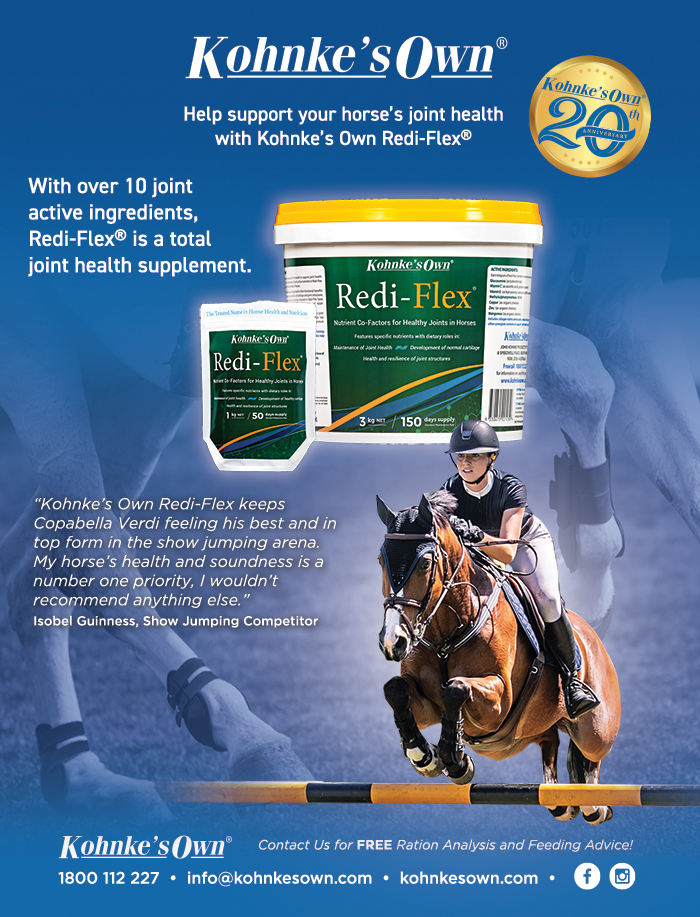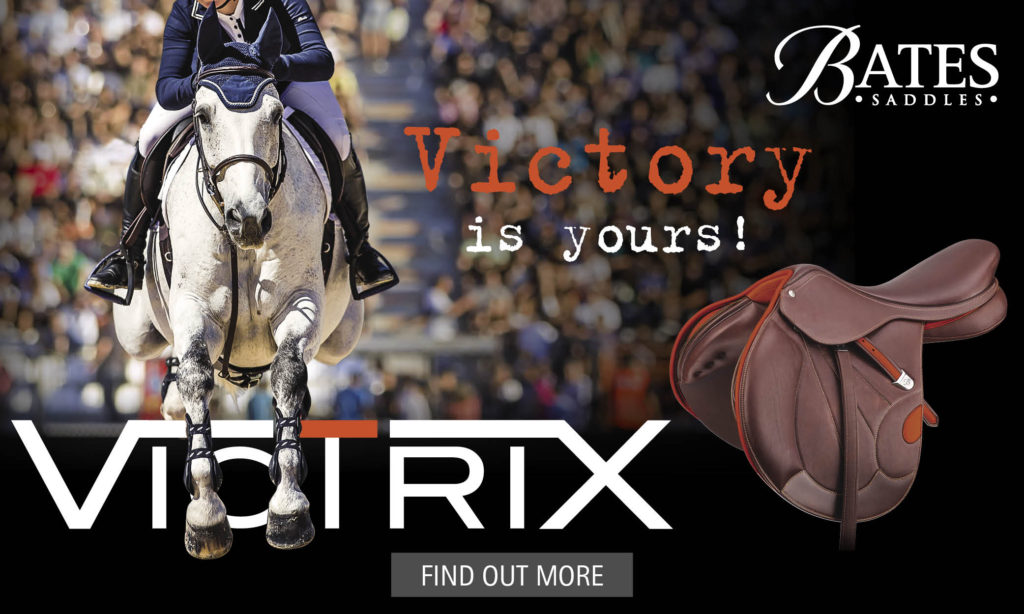Vicki Roycroft takes a Lesson
words Chris Hector, pix Ros Neave
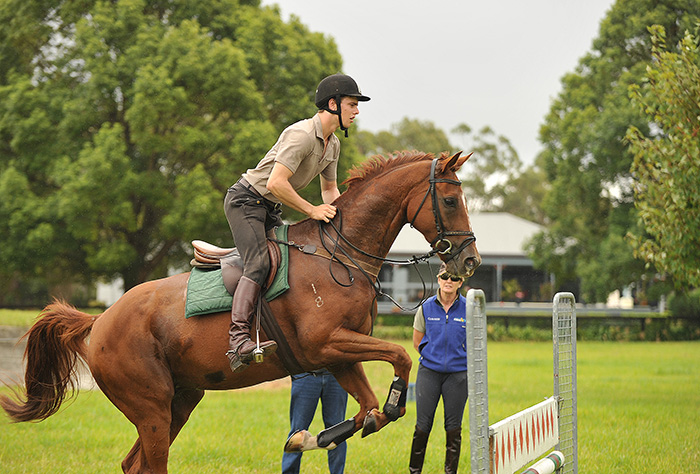
The student is Vicki Roycroft’s pupil, Ben Blay, on his talented but slightly tricky Thoroughbred, Sir Joindre, aka Brad. The subject? That vexed issue of ‘contact’.
Like our dressage riders, showjumping riders have to create the balance, the horse that is light, but not too light, the horse that is on the aids and that will move up to the contact. For jumpers this is doubly essential because it lets them shorten and lengthen the stride and find that elusive ‘right’ spot…
“What I’m looking for in Ben’s riding is the right contact – where the horse is in self carriage, he can feel his horse’s mouth a little, but not too much. Ben is a beautiful rider, he busts his gut to get it right, he has a real passion for the sport. He’s been with me for over a year now, since the George Morris clinic.
“It’s probably a good opportunity for Ben because I’m not riding so many. Ben gets to ride all the young ones. He’s riding a six-year-old mare I bred by Errol (Premier Des Hayettes), Nikki Des Hayettes, who is nearly C Grade. Ben is the perfect stable rider because he has two of his own horses here, but his horses are always at the end of the queue – he understands and is comfortable with that, whereas most kids of his age, they think their horse comes first.”
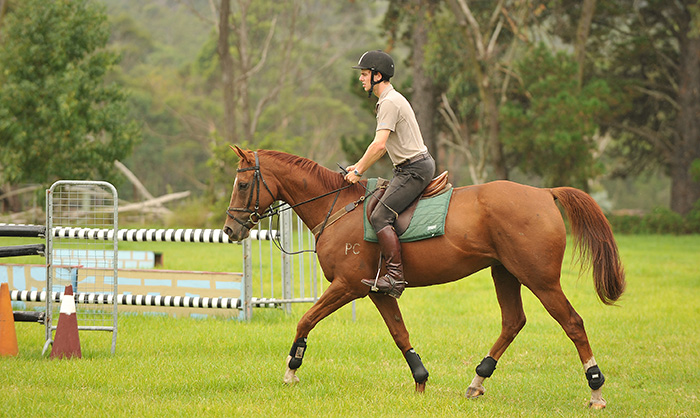
“The horse he’s riding today is his Thoroughbred – it’s a nice horse and quite careful. I don’t know if he is good enough to go all the way, but he is good for this boy because he is still learning his craft. He’s quite a trainable horse.”
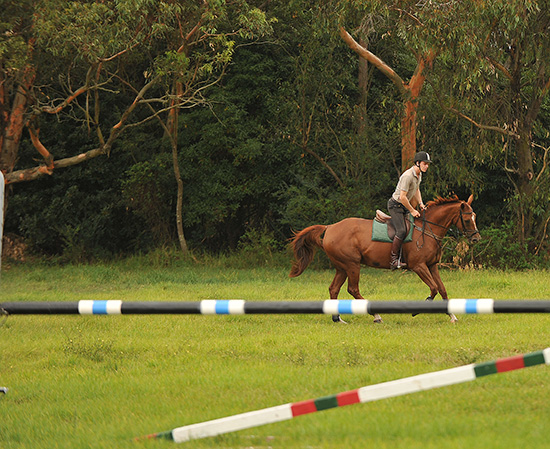
What do you want in the warmup?
“Obviously everything is modelled on the George Morris philosophy, lots of transitions, they’ve got to have gas – willingness to go forward, they’ve got to have brakes, they have to be straight. The horse has to be forward and straight until you tell it otherwise, and this is the hard thing to get through to riders, that they don’t just ride off their horses’ heads. Riders just worry about the horse’s head – but the horse has a hindquarter, a shoulder, and a head and neck. The rider’s lower leg controls the hindquarter, to a certain extent the shoulder is positioned by the legs and hands, and the head and neck are controlled by the rider’s hands, the horse has to think forward and straight. You don’t use the reins to turn the horse, you use the reins to create a bend, your legs and weight turn the horse.
more follows
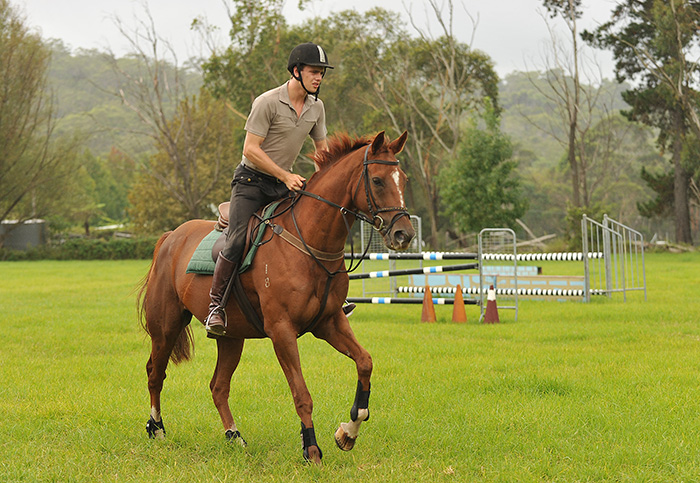
The hardest thing is for people to use their legs effectively, because this sort of horse, like most Thoroughbreds is not used to legs, they are always trying to stop the rider using his legs, and that is why riders start doing a lot with their hands, and their seat. A horse like this is not used to the rider using legs – so the rider uses the other aids.
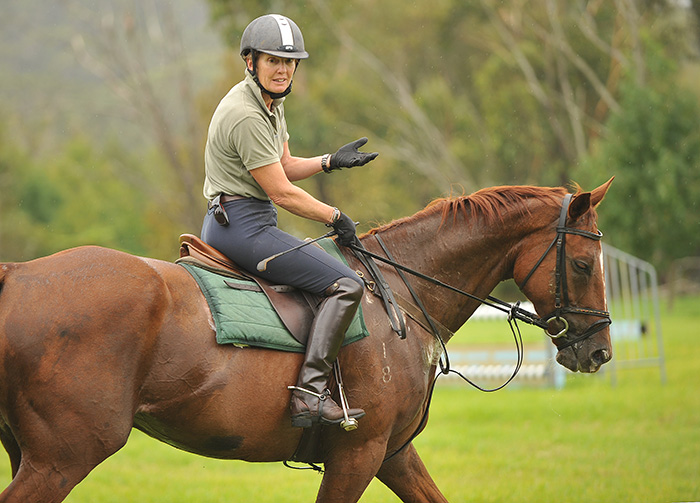
As a rider you have to think every day, am I using enough leg to make things happen? Horses have two reactions to the rider’s leg. The hot horse will run away from the leg, so riders take their legs off, or the cold horse will just ignore the leg, the rider can be kicking away, but nothing happens.
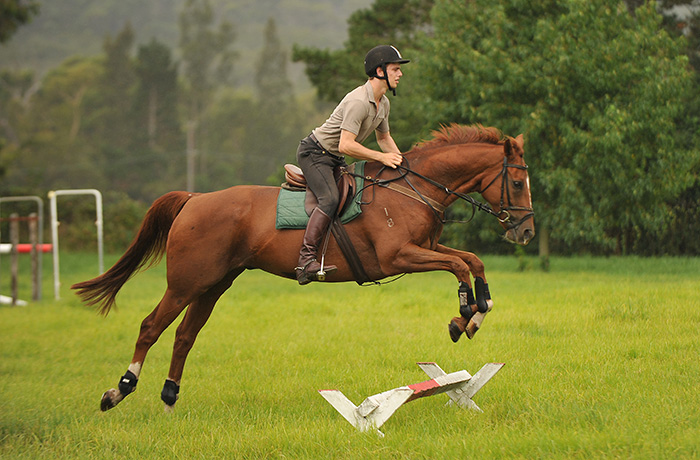
We will start off using poles on the ground and cavallettis. I use them because you can use them every day: they are especially useful for riders with only one horse. You can use poles and cavallettis all you like: you won’t be wearing the horse out, they will help you learn to find a distance, and you are not making the horse sick to death with jumping, nor are you scaring the horse by missing a distance when you are only going over something that is no bigger than a cross rail.
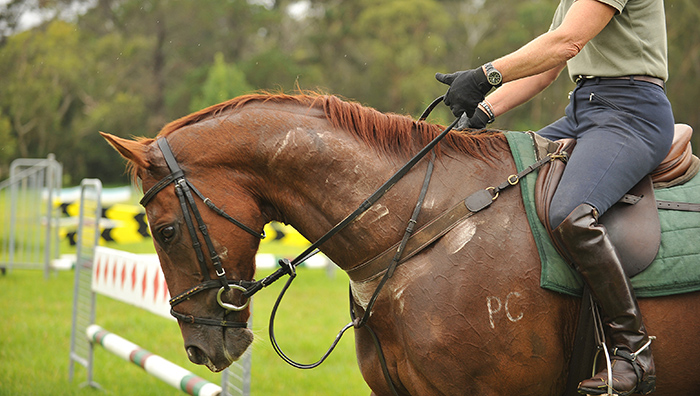
One issue with Ben’s horse is that it can get a little heavy, a little leany. I’ve hammered Ben because he’s done too much with his hands, trying to get his horse back on his hocks: the result of a correct half halt is that the horse goes forward, and goes forward in a balance, that is what you are aiming at. This horse is a real one for getting heavy and planky – stiff, and then he doesn’t jump a good fence because he’s too much on his forehand.
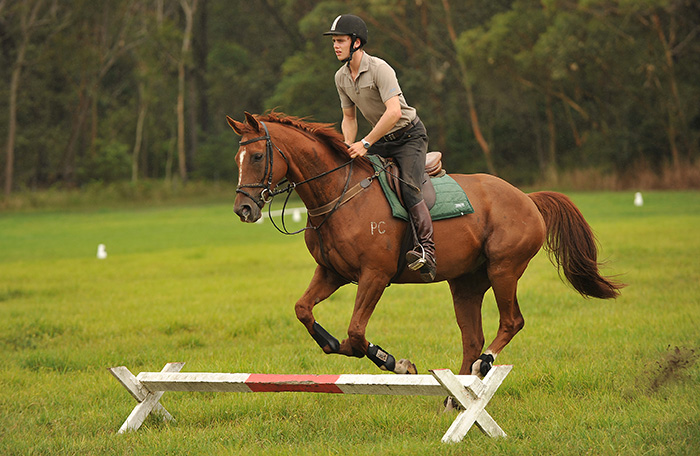
“Pop him over the cavallettis. We stay at flat stirrup length at this stage, until we are about to do some real jumping.”
“Just go back and forth Ben, don’t change your upper body, stay in the middle.”
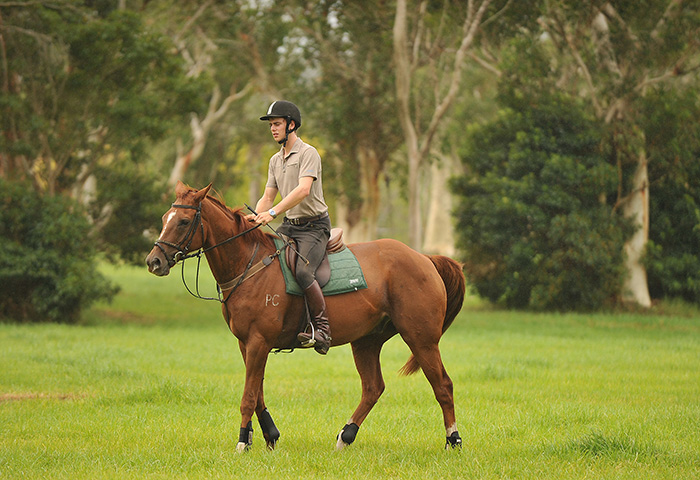
“Now stop him, stop him one time, that’s it, do the little back up. The back up gets the horse on his hocks and off his forehand. They cannot jump off their front end, yet everyone is obsessed about getting their heads down.”
The next exercise had Ben trotting over some small fences…
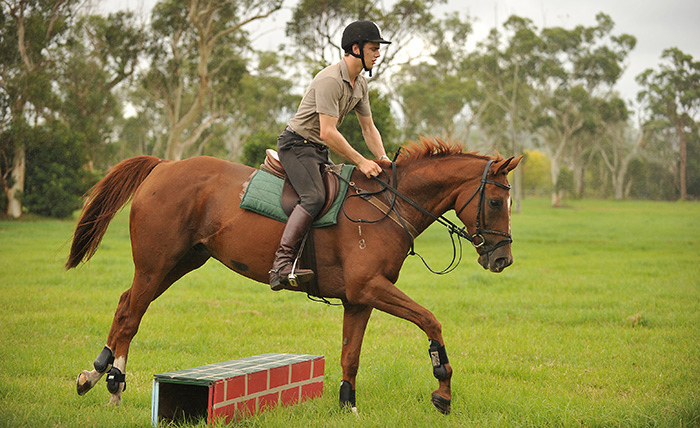
“Normally I have the fences across the hill because it is easier, but when George Morris is here, he makes sure all the exercises are up and down the hill so the jumps are still like that, then through the year gradually they get back to across the hill…”
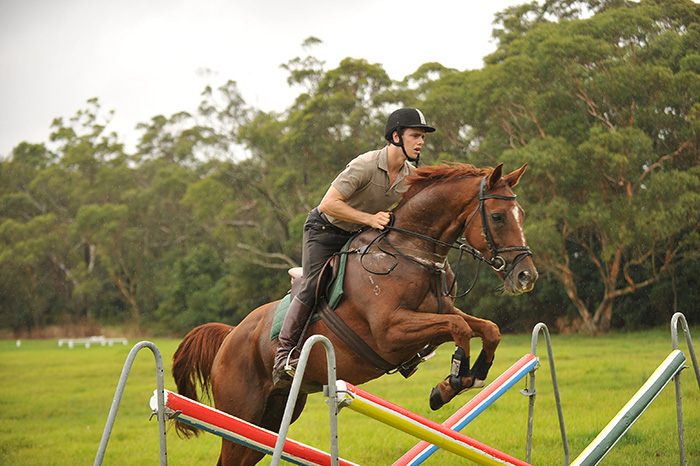
What is this exercise for?
“It is good for riders to trot fences so they don’t get in front of the movement. It is also quite good for the horse, it is a totally no-risk exercise, but it keeps horses honest, if they want to spook.”
“Don’t tip forward, that’s it, remember that little cluck, try not to steer him through your corners, ride him. See how Ben stays absolutely in the middle of the horse, because if you tip out of balance, the horse can duck out.”
Forward and Waiting
“This is a query I get a lot, as riders get stressy about riding ‘the distance or the take-off spot’. So I normally counter with the question, ‘What distance do you want?’ Up to 1.20m, there are about three distances that the rider can comfortably make work, a forward ride, a normal ride or a waiting one. The important thing is to have a good balanced canter where the horse is always thinking forward, but not necessarily fast, so the minor changes can be made within the pace. Riders often forget that there are normally two pairs of eyes on the fence, and the horse, once focused is also trying to find a distance. Then it’s a matter of both horse and rider finding the same one!”
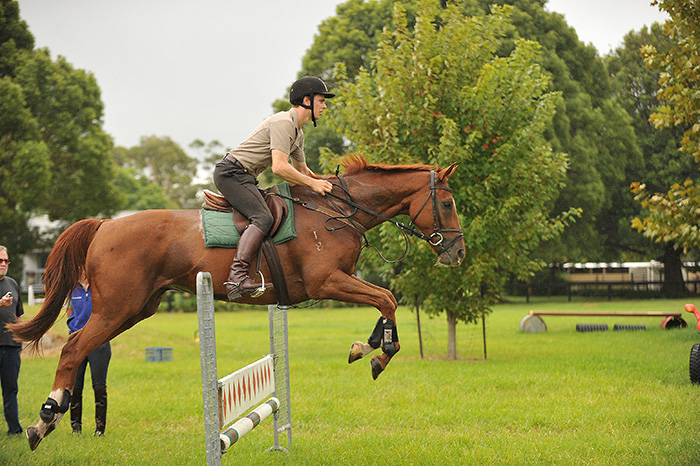
“This time be ready to wait. Ben is inclined to take the forward distance because the horse is looky and unconfident, but if you always take that long more comfortable distance, horses start to get flat.”
“Just come the other way and do the five strides, but try and think of that following hand, rather than just chucking the rein at the horse, and if he doesn’t take the rein, don’t give it to him. Don’t throw rein at him because then he is going to go hollow.”
“Do a little more on a circle before you come to the fence, just to get him reaching. The horse is a little rigid in his neck and stiff in his front.”
“Keep your hands above his mouth, a little above his mouth.”
“Do a bit of leg yielding just to get him more between your inside leg and outside rein so that you’ve got a better connection.”
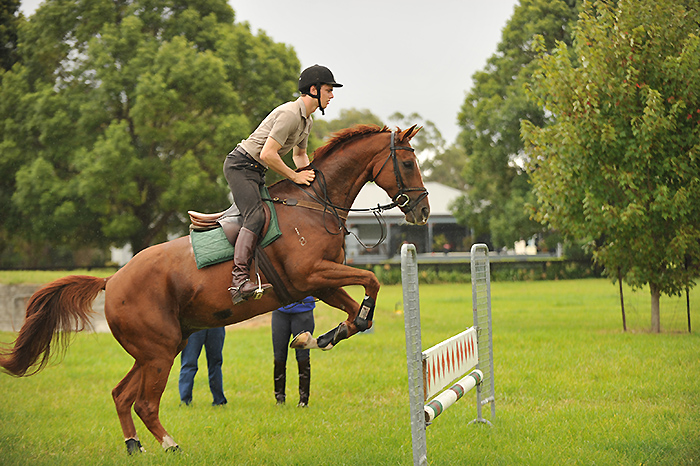
“Land and turn, use your inside leg, inside rein supported by your outside rein to get your horse to make a better of a shape, to follow the rein. I want this horse so that Ben can influence him more, this is a good fence to train a horse over. I’m just worried about the first part of the jump where Ben is throwing the horse rein – okay you give a horse rein in some situations, but what I want this boy to learn about now, is getting the horse following his hand, getting the horse to make a better shape.”
“Let me have a ride, I’m better feeling what the horse is doing…”
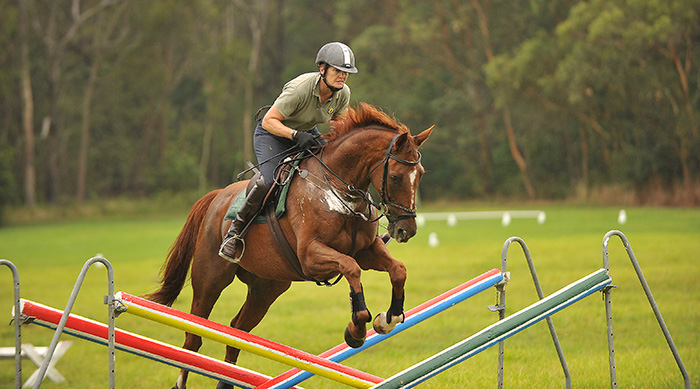
“This guy is a typical Thoroughbred, his reactions are quick, with the Thoroughbreds you are always looking to slow the reactions down, whereas with some of the Warmbloods, you are looking to sharpen them up. I never get on a horse without spurs, I never get on a horse without carrying a stick, okay most of the time you don’t need them, but you need to have them there.”
“It doesn’t matter what exercise you are riding, don’t hurry the transitions, take your time, he is a bit quick at the moment, he is a bit fresh. We don’t take the obvious distance, remember there are a bunch of options there, wait for the next distance at a fence like that which is not too big.”
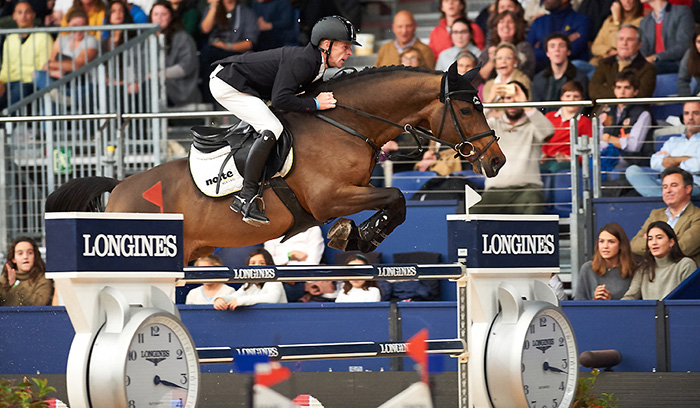
Marcus Ehning and Comme Il Faut – jumping into the rein…
“Come on a shorter turn and think about your inside leg, and that there are a bunch of distances.”
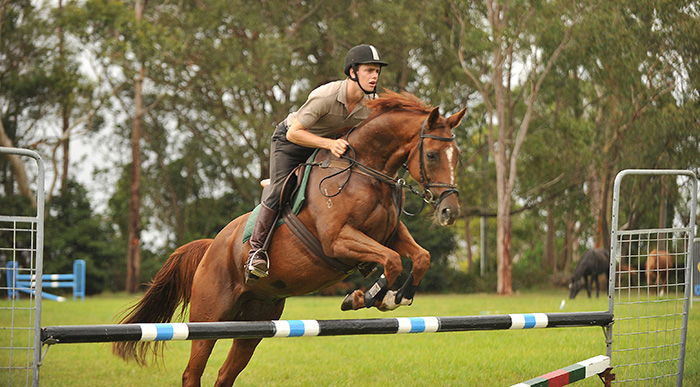
“Perhaps we need to set up a grid, to help you get the feel. With a grid you know exactly when the horse is about to leave the ground, I can set it up so Ben doesn’t have to worry about the distances at all, just focus on that following hand. If you jump from that longer distance then the horse gets hollow, whereas from the deeper distance, it is more like the Marcus Ehning jump – they just jump into your hand. It is not that you’ve got to toss them the rein, they take what rein they need and you give them that.”

